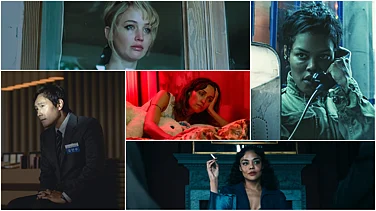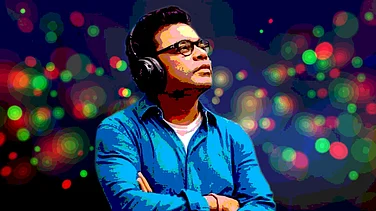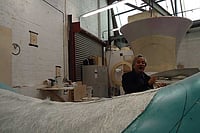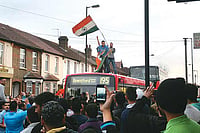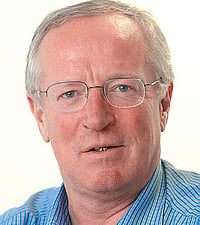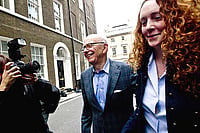Finally, the art world’s most theatrical exponent is coming home. Anish Kapoor’s exhibitions have drawn expansive crowds in major cities across Europe, Asia and the United States for the past two decades, but now, for the first time, the Mumbai-born, London-based artist brings several new sculptures and a retrospective of his life’s work to his motherland, in a typically ambitious and grand project that will run simultaneously in Delhi and Mumbai from late November.
From Kapoor himself comes the revelation that it took a whole decade to make this happen. “This show in India is something we’ve been thinking of for a good 10 years. It’s a curious kind of homecoming. I’m slightly afraid of it, to be perfectly honest—not because I’m afraid of being judged, but there’s something wonderfully mysterious about absence,” says the sculptor, who comfortably straddles the line between darling of London’s trendy, avant garde modern art set and mainstream adulation. Indeed, he merges a talent for sculpture and architecture worthy of praise from a Frank Lloyd Wright or a Rodin with the wily showmanship of a Houdini or a P.T. Barnum.
Kapoor’s works are mighty and usually free to view; they draw crowds that few other artists are able to attract, and are enjoyed by the intelligentsia, whole families, students, critics and the elderly alike. His fans say he toys with the usually static relationship between artists and their audiences, while his critics claim he is little more than a proponent of bling-bling, novelty ‘theme park’ art.
So what exactly will India make of this irrepressible cultural force? “We shall see,” he says in his suave, impeccable English accent, sweeping his hands across the room; and looking, with his black blazer, jeans and wild, silver hair, somewhere between a poet-for-hire and a neo-classical economics professor. “The art world in India is relatively small, so we shall see if the ascetic language of the show can reach beyond that.”
Our conversation unfolds during a tour of his studios, though factory would probably be a better description for a facility that has, over the years, absorbed one side of an entire south London street. From the outside, it looks like a place you would go to change your car tyres, rather than a hothouse where globally acclaimed art germinates. As Kapoor takes us around, much like Willy Wonka shepherding children on a tour of his chocolate factory, there is a sense of seeing behind the conjurer’s curtain—and that nothing is quite what it seems. “This is not a place of engineering, not a place of manufacturing,” he says. “This is a place of experimentation. A place where art lives and an artist can find the space to live.”
We see large moulds of fibreglass, giant mirrors, and sheets of shiny metal. These are after all the materials Kapoor has come to be most associated with over the past 15 years. Currently, his Sky Mirror and Spire—giant mirrored sculptures reflecting their environments—are part of a display in London’s Kensington Gardens. In 2005, his Cloud Gate in Chicago became the most visited popular artwork in the world.
In 2002, his work Marsyas—a giant, twinkling, blazing red tuba-like sculpture comprising three steel rings—had thousands flocking to the Tate Modern gallery to admire the sheer audacity of the 150 m long and 35 m high work. Unsurprisingly, his India show was endlessly deferred because, as he says (see interview), he simply could not find a suitable space. The venues finally chosen—Delhi’s recently refurbished National Gallery of Modern Art and Mumbai’s vast Mehboob film studios—are perfect, Kapoor says.
“The film studio is where Mother India was made, so it has a peculiar resonance with Indian audiences. It’s really a distinct space,” he says, “Recently, Shahrukh Khan and Aishwarya Rai were filming there and the set looked like this incredible mansion. It will be a bit different this time.”
That seems like an understatement, given the sheer magnitude of Kapoor’s sculptures, some perhaps vaguely reminiscent of Diwali or Puja celebration behemoths, but not of anything that stands for art in an Indian context.
Indeed, Kapoor has never been an Indian abroad; he is, rather, an artist existing in that peculiar universe that only artists inhabit. Speaking of his younger days, he says: “I had no idea of what artists do, or how, or anything...my uncle collected a few Indian artists, such as M.F. Husain and Krishan Khanna. But there were no artists in our family or anything like that.” He adds, “I didn’t think of myself as Indian. In those days, it was a different context. In the early 1970s, you were (just) an artist.”
A Doon School alumnus, Kapoor is the son of a Hindu Punjabi hydrographer father and an Iraqi Jewish mother. His maternal grandfather was a rabbi in Bombay but Kapoor himself is a practising Buddhist. He left India at the age of 17 and studied engineering in Israel but found it was not his true calling, and arrived on British shores to attend art school in London, aged 19.
For the confluence of varied influences that Kapoor is, perhaps this Indian journey, at the ripe age of 56, is simply the next stage in his artistic evolution. As he says himself, reflecting on the artist’s burden, in common with that of sharks—in his eccentric way, he cites the financier George Soros as a source of inspiration—to stand still is to perish. “It’s a long game but reinvention is what keeps you going.”
If reinvention is Kapoor’s latest invention, it’s fair to assume that the Indian public will benefit. Apart from several new pieces, they will also see Kapoor’s iconic works such as Shooting into the Corner, a cannon that fires huge blobs of wax into a corner of the gallery; and his bright and bold early pigment works. Whatever their reaction, the artist will not be short of work anytime soon. Just last week, there was a ground-breaking ceremony for his work The Orbit, a “120 m tall Tower of Babel sort of winding stairway” that will grace the London 2012 Olympic Games site. But at least for now, Anish Kapoor, citizen of Artland, is rediscovering his Indian roots.












